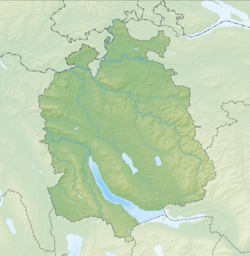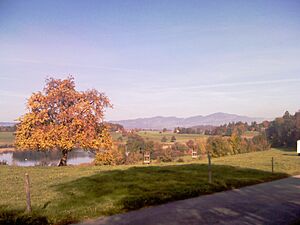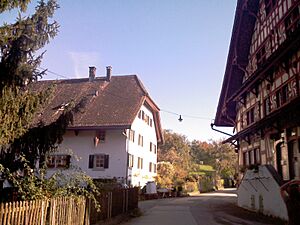Hombrechtikon facts for kids
Quick facts for kids
Hombrechtikon
|
||
|---|---|---|
 |
||
|
||
| Country | Switzerland | |
| Canton | Zurich | |
| District | Meilen | |
| Area | ||
| • Total | 12.18 km2 (4.70 sq mi) | |
| Elevation | 464 m (1,522 ft) | |
| Population
(Dec 2020 )
|
||
| • Total | 8,815 | |
| • Density | 723.7/km2 (1,874.4/sq mi) | |
| Postal code |
8634
|
|
| Localities | Feldbach | |
| Surrounded by | Bubikon, Freienbach (SZ), Grüningen, Jona (SG), Oetwil am See, Rapperswil (SG), Stäfa | |
Hombrechtikon is a town, also called a municipality, located in the Meilen district of the Zürich canton in Switzerland. It's a place with a rich history and beautiful natural surroundings.
Contents
History of Hombrechtikon
Hombrechtikon was first mentioned in official papers way back in the year 1200. At that time, its name was written as Humbrechtigkon. A few years later, in 1217, it was called Hunbrechticon.
Exploring Hombrechtikon's Geography
Hombrechtikon covers an area of about 12.2 square kilometers (about 4.7 square miles). A big part of this land, about 60%, is used for farming. Forests cover almost 15% of the area. The rest of the land, about 18.7%, has buildings and roads. A small part, 5.8%, is made up of non-productive areas like rivers or lakes.
The municipality is located between the beautiful Lake Zurich and the Zürcher Oberland region. The land here is quite hilly. Because of the hills, Hombrechtikon doesn't have one big central village. Instead, it has at least 97 smaller groups of houses and farms, called hamlets, spread out. Some of the larger hamlets are Lützelsee, first mentioned in 745, and Feldbach, mentioned in 873.
People and Life in Hombrechtikon
Hombrechtikon has a population of about 9,200 people. Around 16.7% of the people living here are from other countries. The population has been growing steadily over the last ten years.
Most people in Hombrechtikon, about 89%, speak German. Italian is the second most common language, spoken by 2.4% of the population, followed by Albanian at 1.7%.
Age and Education
In Hombrechtikon, about 25.5% of the population are children and teenagers (under 19 years old). Adults (20-64 years old) make up 60.8%, and seniors (over 64 years old) are 13.7%. Most adults in Hombrechtikon are well-educated. About 77.9% of people aged 25-64 have finished high school or gone on to higher education, like university.
Jobs and Work
Hombrechtikon has different types of jobs.
- Primary Sector: This includes jobs like farming. About 260 people work in this area.
- Secondary Sector: This involves manufacturing and construction. About 983 people work in these jobs.
- Tertiary Sector: This covers services like shops, offices, and healthcare. About 1305 people work in this sector.
Many people work part-time, with about 58.4% of the working population having part-time jobs.
Religion
In Hombrechtikon, the two main religions are Protestantism and Catholicism. About 51.4% of the people are Protestant, mostly belonging to the Swiss Reformed Church. Around 28.9% of the population are Catholic. Some people belong to other religions, and about 10.6% do not follow any religion.
Population Growth Over Time
Here's how Hombrechtikon's population has changed through history:
| Year | Population |
|---|---|
| 1634 | 617 |
| 1772 | 1,501 |
| 1850 | 2,649 |
| 1900 | 2,292 |
| 1950 | 3,079 |
| 1980 | 6,001 |
| 2000 | 7,246 |
Getting Around Hombrechtikon
The village of Feldbach and its train station are located right on the shore of Lake Zürich. Hombrechtikon itself is situated higher up, near the Pfannenstiel hill. The Hombrechtikon-Feldbach railway station is a stop on the S-Bahn Zürich train line, which is called S7.
Important Heritage Sites
Hombrechtikon is home to several important historical places. Seven sites in the municipality are listed as Swiss heritage sites of national significance. These include:
- The Hof Oberhaus at Seestrasse 2&4.
- The Hürlimannhaus at Lützelsee 2&4.
- The Landstiz Rosenberg at Alte Landstrasse 1&3.
- The Menzihaus at Lützelsee 3.
- The Eglihaus at Lutikon 1-3.
- The town's Reformed church.
- An ancient settlement from the neolithic (New Stone Age) and early Bronze Age periods at Feldbach.
The entire hamlet of Lützelsee and the Feldbach area are also part of the Inventory of Swiss Heritage Sites. The prehistoric settlement at Feldbach is even part of the Prehistoric Pile dwellings around the Alps, which is a special UNESCO World Heritage Site. This means it's recognized as important to the whole world!
See also
 In Spanish: Hombrechtikon para niños
In Spanish: Hombrechtikon para niños









